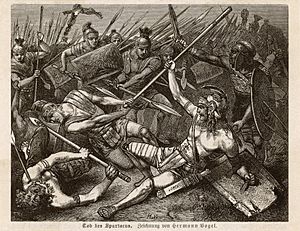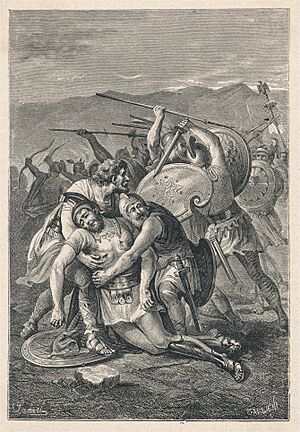Spartacus facts for kids
Quick facts for kids
Spartacus
|
|
|---|---|

The Death of Spartacus by Hermann Vogel (1882)
|
|
| Born | c. 103 BC Near the Strymon river in present-day Bulgaria |
| Died | 71 BC (aged 32) Near Sele River in Lucania, Italy |
| Years of service | 73–71 BC |
| Commands held | Rebel slave army |
| Battles/wars | Third Servile War |
Spartacus (Greek: Σπάρτακος Spártakos; Latin: Spartacus; around 103–71 BC) was a Thracian gladiator. He was one of the main leaders of a huge slave uprising against the Roman Republic. This event is known as the Third Servile War.
Not much is known about Spartacus before this war. However, all historical records agree that he was a former gladiator and a very skilled military leader. Many people see this rebellion as an example of people fighting for their freedom. It has inspired many thinkers and appeared in books, TV shows, and movies.
Contents
Who Was Spartacus?
Early Life and Background
Historians describe Spartacus as a Thracian, which means he came from the region of Thrace. This area is in present-day south-western Bulgaria. Some accounts say he was from a nomadic tribe called the Maedi.
One historian, Appian, wrote that Spartacus had served as a soldier with the Romans. Later, he was captured and sold into slavery. Another writer, Florus, said he was a Thracian soldier who deserted and then became a slave.
Plutarch, another historian, mentioned that Spartacus's wife was also enslaved with him. She was a prophetess from the Maedi tribe. Experts believe Spartacus was about 30 years old when the revolt began.
Becoming a Gladiator
Spartacus was taken captive by Roman soldiers. He was then trained at a gladiator school in Capua, Italy. This school belonged to a man named Lentulus Batiatus. Spartacus was a "murmillo," a type of heavyweight gladiator. These fighters used a large shield and a short sword.
In 73 BC, Spartacus and about 70 other slaves at the school planned to escape. They used kitchen tools to fight their way out. They then grabbed weapons and armor from wagons.
The Escape from Capua
The escaped slaves defeated Roman soldiers sent to catch them. They took supplies from the area around Capua. Many other slaves joined them, making their group bigger. They then moved to a strong defensive spot on Mount Vesuvius.
Once free, the escaped gladiators chose Spartacus, Crixus, and Oenomaus as their leaders. Roman writers often focused on Spartacus as the main leader. However, it's possible that the escaped slaves had a more equal leadership among themselves.
The Great Slave Revolt
The Third Servile War Begins
The Romans were busy fighting other wars, so their main armies were away. They first thought the slave rebellion was just a small problem. Rome sent a commander named Gaius Claudius Glaber with a militia (a citizen army). He tried to trap Spartacus and his men on Mount Vesuvius. Glaber hoped they would starve and surrender.
Clever Tactics on Mount Vesuvius
But Spartacus surprised the Romans. His men used ropes made from vines to climb down the steep side of the volcano. They attacked the Roman camp from behind, where it was not protected. Most of Glaber's militia were killed.
The rebels also defeated a second Roman army. They almost captured the Roman commander and took his military gear. Because of these victories, more and more slaves joined Spartacus. Many shepherds and herdsmen also joined, making the army grow to about 70,000 people.
A Diverse Army
Spartacus's army included people from many different backgrounds, like Celts and Gauls. Some of them had even been Roman soldiers before. Slaves from the countryside were often better prepared for fighting. City slaves were less used to hard outdoor life.
Spartacus showed he was an excellent tactician. Even without formal training, his army used clever methods and local materials against the well-trained Roman legions. They spent the winter of 73–72 BC training their new recruits. They also expanded their territory, raiding towns like Nola and Thurii. It seems the slaves operated in two groups, led by Spartacus and Crixus.
Roman Legions Join the Fight
In the spring of 72 BC, the rebels moved north. The Roman Senate became very worried. They sent two powerful Roman armies, led by consuls Lucius Gellius and Gnaeus Cornelius Lentulus Clodianus.
The Roman armies first defeated a group of 30,000 rebels led by Crixus. But then, Spartacus defeated the Roman armies. These defeats made the Senate even more alarmed.
Crassus Takes Command
The Senate then asked Marcus Licinius Crassus to end the rebellion. Crassus was the richest man in Rome. He took command of eight legions, which was about 40,000 trained Roman soldiers. Crassus was very strict. He even brought back a harsh punishment called "decimation." This meant one out of every ten of his own soldiers was killed if they failed. He wanted them to fear him more than the enemy.
Spartacus and his followers had moved south in Italy. When they started moving north again in early 71 BC, Crassus sent his legions to block them. One of Crassus's officers, Mummius, attacked the rebels too early and was defeated. But after this, Crassus's legions won several battles. They pushed Spartacus further south through Lucania. By the end of 71 BC, Spartacus was trapped near the Strait of Messina in Rhegium.
Trapped and Betrayed
Plutarch wrote that Spartacus tried to make a deal with pirates from Cilicia. He wanted them to take him and about 2,000 of his men to Sicily. There, he hoped to start another slave revolt and get more fighters. However, the pirates took his payment but then left the rebels behind.
Spartacus's forces then went back towards Rhegium. Crassus's legions followed and built strong walls across the narrow land strip at Rhegium. This trapped the rebels and cut off their supplies.
The Final Battle
At this time, the Roman general Pompey was returning from Spain. The Senate ordered him to go south and help Crassus. Crassus was worried that Pompey would get all the credit for defeating Spartacus.
Hearing about Pompey, Spartacus tried to make a truce with Crassus. When Crassus refused, Spartacus and his army broke through the Roman walls. They headed towards Brundusium, with Crassus's legions chasing them.
The Roman legions caught a part of the rebel army that had separated. Discipline among Spartacus's forces broke down. Small groups of rebels started attacking the Romans on their own. Spartacus then turned his entire army around for a final stand. The rebels were completely defeated, and most of them were killed on the battlefield.
The last battle where Spartacus was likely defeated happened in 71 BC. It took place near the Sele River in an area that was part of Lucania. Historians Plutarch, Appian, and Florus all say Spartacus died in this battle. However, Appian also wrote that his body was never found.
After the battle, Crassus's legions captured 6,000 survivors. These survivors were crucified along the Appian Way, a major road from Rome to Capua.
What Did Spartacus Want?
Historians have different ideas about what Spartacus's goals were. None of his actions clearly show that he wanted to change Roman society or end slavery completely.
Plutarch wrote that Spartacus wanted to escape north into Cisalpine Gaul (northern Italy) and let his men go back to their homes. If escaping Italy was his goal, it's not clear why he turned south after defeating the Roman armies, which had left a clear path over the Alps.
Appian and Florus wrote that Spartacus planned to march on Rome itself. Appian also said he later gave up on this goal. This idea might have just been what the Romans feared.
Some events suggest that parts of the escaped slave army preferred to steal from towns in Italy rather than escape over the Alps.
Spartacus's Legacy
Spartacus has become a symbol for freedom and rebellion throughout history.
An Inspiration for Change
Toussaint Louverture, who led the slave revolt that made Haiti an independent country, was called the "Black Spartacus."
Adam Weishaupt, who started a group called the Bavarian Illuminati, often called himself Spartacus in his letters.
Spartacus and Communism
In modern times, Spartacus became an important figure for communists and socialists. Karl Marx, a famous thinker, called Spartacus "the most splendid fellow in the whole of ancient history." He saw him as a great leader who represented the working class of ancient times.
Spartacus inspired many left-wing revolutionaries. For example, the German Spartacus League (1915–18) was named after him. This group later helped form the Communist Party of Germany. An uprising by communists in Germany in 1919 was even called the Spartacist uprising.
Spartacus in Sports
Many sports clubs around the world, especially in the former Soviet Union and other communist countries, were named after Spartacus.
- In Russia: FC Spartak Moscow (football), HC Spartak Moscow (ice hockey).
- In Ukraine: FC Spartak Sumy (football).
- In Bulgaria: FC Spartak Varna (football).
- In Serbia: FK Spartak Subotica (football).
- In Slovakia: FC Spartak Trnava (football).
The Spartakiad was a sports event in the Soviet bloc, similar to the Olympic Games. The mascot for the Ottawa Senators hockey team, Spartacat, is also named after him.
See also
 In Spanish: Espartaco para niños
In Spanish: Espartaco para niños


